Heritage and Sustainability
Dennis Rodwell
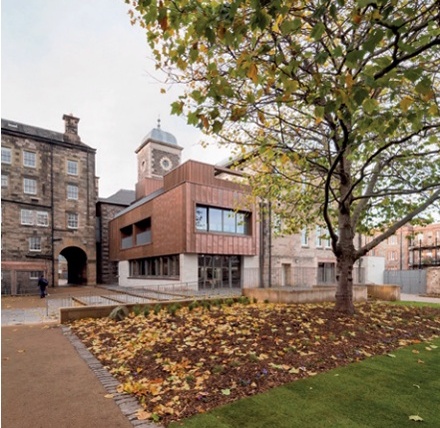 |
|
| The Edinburgh Centre for Carbon Innovation, which opened in 2013, is a category A listed former school. Its refurbishment used low carbon materials including highly engineered timber and reclaimed steelwork. It is the first refurbished historic building in the UK to achieve a BREEAM ‘Outstanding’ rating. (Photo: Dave Morris) |
Today, past the halfway mark in the first quarter of the 21st century, we are challenged by a number of coincidental global agendas: the exhaustion of the key non-renewable material and energy resources which industrialised and developing countries currently depend on; recognition of the relationship between the burning of fossil fuels, carbon dioxide emissions and global warming (‘climate change’); and the agenda of sustainable development, articulated in the 1987 Brundtland Report, affirmed at the 1992 Rio de Janeiro Earth Summit, and reinforced in the 2015 United Nations Sustainable Development Goals.
Sustainable development has many interpretations, but two will suffice in the context of this article.
First, the concept of sustainability is defined in ecology as the capacity of systems to endure and remain diverse and productive over time. It signifies durability, is dynamic and not static, and presupposes resilience and adaptability to change.
Elaborating this, sustainable development is defined in the 1991 publication Caring for the Earth as development directed at ‘improving the quality of human life while living within the carrying capacity of supporting ecosystems’ (see Further Information for details of all cited publications). The 2010 European Union Toledo Declaration on Urban Development encapsulates the multiple dimensions of sustainability as ‘economic, social, environmental, cultural and governance’. It stresses the importance of cultural heritage alongside building rehabilitation.
Second, whereas the Brundtland Report has been criticised in many quarters for its emphasis on economic growth, an oft-overlooked passage on the first page reads: ‘We see the possibility for a new era of economic growth, one that must [author’s italics] be based on policies that sustain and expand the environmental resource base’.
The environmental resource base that concerns us here has two components, renewable and non-renewable. The latter divides into the unexploited, for which tables of reserves and projected expiration dates are regularly published, and the exploited. The environmental resources already exploited for the development of our existing buildings and urban infrastructure include both the materials themselves and the fuels used in their extraction, manufacture, transportation and construction – their ‘embodied energy’. This investment provides the building conservation and retrofit sector with a vital role in today’s global agendas which extends beyond a reductionist focus on ‘architectural or historic interest’ premised on selective survival.
In a Europe-wide context the importance of conserving this embodied resource is underlined by the estimation that 80 per cent of the buildings that will exist in the year 2050 have already been built. This figure varies regionally, increasing to 87 per cent relative to the housing stock in Scotland for example.
 |
|
| Thermal image composition showing heat loss from Bute House, Edinburgh (Image: Kal Murray, Eco Surveys) |
Analysis of the embodied energy and materials of historic buildings provides important indicators:
- it prioritises a holistic evaluation of the long-term energy investment as well as performance in use of all older buildings
- it broadens perception of the value of our built heritage beyond delimited cultural criteria to embrace environmental resource, societal factors and usefulness
- it highlights the potential for mainstreaming retrofit measures beyond a restricted heritage sector, up-scaling traditional methods in tandem with appropriate new technologies
- it facilitates the development of manifold options for balancing energy-related objectives with those of heritage significance, ones that are normal and affordable rather than specialist and expensive.
In short, understanding sustainability requirements provides a major opportunity for the heritage sector to expand its field of activity and influence in concert with the mainstream retrofit sector.
UNDERVALUED ENERGY PERFORMANCE
An important starting point is to address negative assumptions regarding the energy performance of our existing building stock, especially older buildings constructed using traditional materials and techniques.
The conventional criteria for identifying and calculating thermal performance across the built environment rely on simplistic thermal transmittance or U-values, ignore factors such as thermal inertia, and employ standardised and generally high assumptions concerning acceptable indoor temperature levels. The variation in performance as well as human comfort levels experienced between buildings of diverse constructional types is not taken into account, the behavioural patterns of building occupants as well as their tolerance of variabilities is ignored, and the results obtained from different energy certification systems – all of which are modelled theoretically – can vary significantly.
The current measurement criteria combine to undervalue the thermal performance of older buildings and create an expectation that intensive levels of intervention are required to make them energy efficient, ones that anticipate conflict with their heritage significance while proving less effective than assumed. Additionally, there is no industry-agreed methodology for calculating and comparing the embodied materials and energy of diverse typologies of buildings by age and construction or of interventions into them, and lifecycle parameters and analyses are either neglected or poor.
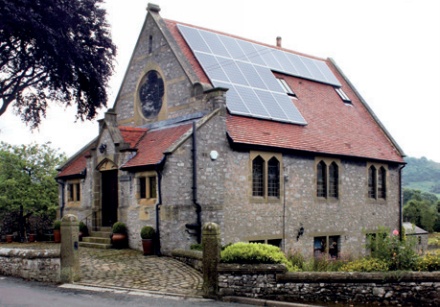 |
|
| Austwick, Lancashire: house conversion. Heritage significance subsumes appearance and material fabric. In this case, whereas the material fabric has been retained by overlaying solar panels, the building’s appearance has been seriously compromised. Advances are being made in the production of solar roof tiles, also shingles and slates, which protect the overall as well as detailed appearance of historic buildings but require substitution of the fabric. The heritage impact methodology outlined in this article facilitates informed and transparent decision-making in situations where choices have to be made. (All photos: Dennis Rodwell) |
In 2007, based on research of energy consumption data across a broad cross-section of its building stock, the Ministry of Justice in England confounded preconceptions by demonstrating that its oldest, pre-1900 buildings use the least energy. The research also demonstrated that the performance of these older buildings was not approached in new construction until the 1990s and 2000s, decades during which energy use was still eight per cent higher per square metre than for the pre-1900 buildings. As the architect Jon Wallsgrove has written: ‘This innovative research... has shown that the conservation of our architectural heritage is directly compatible with energy conservation, rather than being diametrically opposed, as some environmental fundamentalists believe’.
In the light of these and related findings both at home and abroad, priority has been attached by the historic environment agencies and others across the United Kingdom to the research and promotion of benign interventions and limiting detrimental impacts on the historic and traditional building stock. Notable in this regard is the ongoing applied research by Historic England (formerly English Heritage) and Historic Environment Scotland (formerly Historic Scotland), the Building Research Establishment, Changeworks, the Society for the Protection of Ancient Buildings (SPAB) and the Sustainable Traditional Buildings Alliance (STBA), and research conducted in historic cities including Bath, Bristol and Edinburgh.
CONSERVATION PRINCIPLES AND HERITAGE IMPACT METHODOLOGY
‘Significance’ is the collective term used by heritage professionals to encapsulate the diverse heritage values that can be ascribed to a building. These values may include artistic, symbolic, historical, social, economic, scientific and technological attributes.
Assessment is the key to articulating heritage values, whether for statutory designations or local recognition, and the preparation of statements of significance is generally a pre-requisite where interventions are proposed. Statements of significance aim to:
- identify the ‘character defining elements’ of a building and its curtilage
- describe the degrees of significance (typically, from high to none) that attach to setting, form and appearance, components (such as doors and windows) and material fabric
- facilitate accurate and transparent assessment of the overall and detailed impact of retrofit measures (from none to high).
A successful retrofit procedure additionally requires:
- detailed examination of existing needs for repair and conservation
- assessment of the thermal characteristics and performance of the building envelope, for which expertise in thermal imaging is a crucial advance on theoretical U-values
- analysis of heating and electrical systems
- understanding of moisture effects and humidity
- assured competences in the requisite disciplines.
A main objective of the 2012-16 European research project Energy Efficiency for EU Historic Districts’ Sustainability (EFFESUS), was to develop a heritage impact assessment methodology for the selection and prioritisation of cost-effective life cycle energy efficiency improvements at the urban district scale. For this, given that listed buildings account for less than three per cent of the total, an inclusive definition of historic urban district was adopted. The definition covers almost a quarter of the building stock: ‘a significant grouping of old buildings, built before 1945 and representative of the period of their construction or history, and comprising buildings which are not necessarily protected by heritage legislation’.
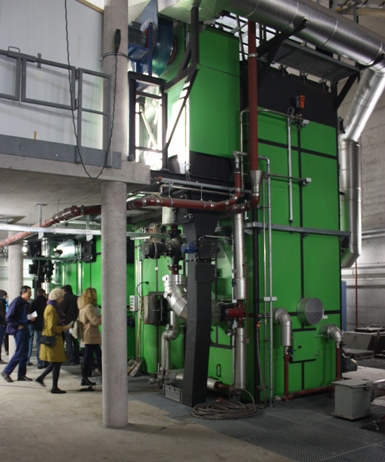 |
|
| Lörrach, Baden-Württemberg, south-west Germany: biomass-fuelled urban-district heating plant. District energy systems, whether for heating/cooling or electricity, are more cost-effective and sustainable and avoid impacting on the heritage significance of individual buildings. |
An essential premise was that building-scale approaches are inefficient and costly, and urban strategies which identify representative typologies of buildings will support the economies of scale associated with mainstreaming retrofit technologies, as well as achieve the reductions in greenhouse gas emissions anticipated in EU directives (targets which the UK is independently committed to achieving under the Climate Change Act 2008).
Adopting the principle of holistic understanding of the suitability of specific retrofit measures in any given situation, heritage impact assessment is one of six complementary modules in the EFFESUS project. The other modules are operational energy, indoor environment (air quality and humidity), fabric compatibility, embodied energy (of retrofit measures) and economy.
A complementary component of the EFFESUS project has been the research and testing of fabric retrofits incorporating new technologies. These include high-performance insulating lime mortars for use externally as render and internally as plaster, silica aerogel fibre insulation as infill to cavities behind internal dry linings, and advanced window systems with integrated air supply valves and shading blinds connected to building management systems.
Essential to the overarching context is that heritage values are maintained and interventions and their consequences have minimal ecological impact. Minimum intervention is a core conservation principle and encapsulates both objectives. It is also essential that all actors are focussed on elaborating properly considered retrofit solutions that are long- rather than short-term and do not respond to individual concerns (such as simply reducing heating bills) while provoking others (such as moisture and health issues). Retrofit solutions should be communicated to building owners and occupants in ways that express what they can do rather than what they can’t and, most importantly, why they have been chosen.
SAMPLE RETROFIT MEASURES
Retrofit measures fall into two main categories: those that improve the thermal and energy performance of buildings (fabric and services) and those that change the energy supply source from fossil fuels to renewables, whether at the individual building scale or at the urban district level.
If the reduction of carbon emissions is the sole or primary objective, then a balanced approach that converts the energy source to renewables can limit the need for fabric interventions, especially those which would impact prejudicially on a building’s heritage significance. In this, rapid advances are being made across the multiple options for renewables – solar, wind, biomass, ground, air and water source heat exchangers, micro hydroelectric and others. Advances are also being made in defining methodologies for cradle-to-grave carbon emission audits to confirm whether or not certain technologies really are ‘green’ as opposed to just appearing to be so.
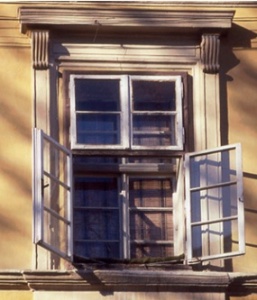 |
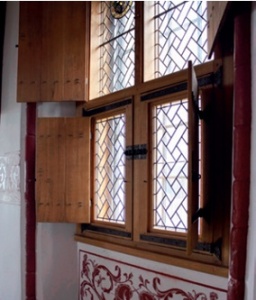 |
|
| Above left: Sibiu, Romania - historic double windows, typical of those found throughout Central and Eastern Europe. Above right: Stirling Castle, Scotland: crafted secondary glazing and shutters have been installed as part of the restoration works in the royal apartments. | ||
For fabric retrofits, the starting point is to fully understand what are the weakest areas and components of buildings (which are not necessarily those promoted in government programmes such as cavity-wall insulation and window replacement), and what are the most cost-effective and sustainable ways of dealing with them: from roofs to walls and floors, windows and doors, and involuntary leakage. New solutions such as those researched for the EFFESUS project need to be promoted in tandem with the recovery of traditional solutions.
The weakest links in buildings are often their roofs – frequently simple to remedy with ecologically-friendly insulation materials such as sheep’s wool – and windows. From a heritage significance as well as an ecological perspective, however, windows can be the most challenging to retrofit. What merit is there in replacing a repairable 250-year-old timber window with one which may, in whole or part, only last a maximum of 25 years? A particular problem arises with the glass, and this author has yet to be convinced that the building industry is able to resolve the inherently limited lifespan of sealed double- and triple-glazing.
Double windows and secondary glazing, which tests have demonstrated to have thermal characteristics at least as good as if not better than sealed glazing units, have been the norm across much of continental Europe for centuries. They often offer a viable alternative that accords with the heritage principle of minimum intervention, is not subject to failure of the glazing technology, and is highly durable.
COORDINATED, COST-EFFECTIVE ACTION
An increasingly invoked truism is that the most sustainable building is the one that has already been built. Lack of holistic understanding and simplistic energy certification systems serve to undervalue the energy performance of our existing building stock, especially older, traditionally constructed buildings.
The retrofitting of our built heritage requires a methodical approach to assessing and respecting its heritage significance in whole and in its discrete parts. Europe’s building stock has a historical and projected longevity that constitutes a major contribution to the reduction of global carbon emissions: through the environmental capital that has already been invested in it; and through the potential for significantly reducing or eliminating the occupancy emissions by a combination of energy efficiency retrofitting and conversion to renewable energy sources.
To meet global emissions reduction targets, we need to mainstream retrofit measures and systems to satisfy complementary objectives. Central to this are principles that have hitherto been most closely associated with the heritage sector, including minimum intervention and minimal ecological impact. Common ownership of these across the whole retrofit sector will enable coordinated, cost-effective action at the scale that is required to counter the predicted impacts of anthropological global warming.
~~~
Further Information
EFFESUS Consortium, Energy Efficiency in European Historic Urban Districts: Practical Guidance, 2016
European Union, Toledo Declaration on Urban Development, 2010
C Hermann and D Rodwell, ‘Heritage Significance Assessments to Evaluate Retrofit Impacts’, in B Szmygin (ed), How to Assess Built Heritage?, Heritage for Future, Florence-Lublin, 2015
C Hermann and D Rodwell, ‘Retrofit Measures for Historic Buildings and Cities’, in Context 142, 2015
J Hulme and S Doran, In-situ Measurements of Wall U-values in English Housing, BRE, Watford, 2014
D Rodwell, ‘Climate Change and Energy Initiatives in Scotland’, in Context 115, 2010
J Wallsgrove, ‘The Justice Estate’s Energy Use’, in Context 103, 2008
C Wood, ‘Making Historic Buildings Even More Sustainable’, in Context 111, 2009
World Commission on Environment and Development, Our Common Future (aka The Brundtland Report), OUP, Oxford, 1987
The World Conservation Union, United Nations Environment Programme and World Wide Fund for Nature, Caring for the Earth: A Strategy for Sustainable Living, 1991



